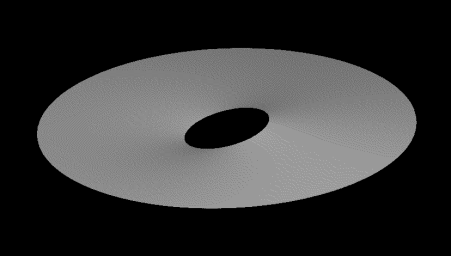This animated graphic shows in a series of three images how Saturn's rings, after they became tilted relative to Saturn's equatorial plane, would have transformed into a corrugated ring.
Images taken after Saturn's August 2009 equinox from NASA's Cassini spacecraft revealed alternating light and dark bands extending from Saturn's D ring, completely across the C ring, and right up to the inner B ring edge (see PIA11664). These brightness variations are almost certainly caused by the changing slopes in the rippled ring plane, much like the corrugations of a tin roof.
This series of images shows how such a vertical corrugation can be produced from an initially inclined ring by the natural tendency for inclined orbits to wobble systematically and slowly at different rates, depending on their distance from Saturn. The top image shows a simple inclined ring (the central planet is omitted for clarity), while the lower two images show the same ring at two later times, where the ring particles' wobbling orbits have sheared this inclined sheet into an increasingly tightly-wound spiral corrugation.
Cassini images show the corrugation extends for 19,000 kilometers (12,000 miles). Based on detailed studies of this structure, scientists conclude that a broad swath of the rings became suddenly tilted in the early 1980s, likely because cometary debris crashed into the rings. The corrugation's radial extent implies that the impacting material was a dispersed cloud of debris instead of a single object. The corrugation's amplitude of 2 to 20 meters (7 to 60 feet) indicates that the debris' total mass was around 1 trillion kilograms (or one billion metric tons).
The Cassini-Huygens mission is a cooperative project of NASA, the European Space Agency and the Italian Space Agency. The Jet Propulsion Laboratory, a division of the California Institute of Technology in Pasadena, manages the mission for NASA's Science Mission Directorate, Washington, D.C.
For more information about the Cassini-Huygens mission visit http://www.nasa.gov/cassini and http://saturn.jpl.nasa.gov/.

 Planetary Data System
Planetary Data System












